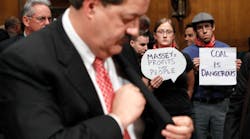The federal indictment of Don Blankenship, former CEO of Massey Energy, is very clear and readable. It describes the behavior of a person who doesn’t seem to care about the lives of the workers in his company, but who does care deeply about maximizing profits. Of course, there is nothing wrong with making money, as long as you don’t intentionally or recklessly kill people to do it.
The federal grand jury indictment of Blankenship is based on the testimony before the grand jury. Blankenship will have an opportunity to offer his rebuttal of that testimony when he gets to court. However, it appears that the grand jury has seen voluminous evidence regarding his conduct. The indictment is so clear and interesting that I encourage you to read it.
There is an important element missing from this indictment. In all fairness, the missing part needs to come from a county, not the federal, grand jury.
The federal indictment describes in great detail that Blankenship had knowledge of hundreds of violations of mine safety rules at the Upper Big Branch Mine (UBB), and it describes that he did not provide the resources to fix those violations. It also notes that the company had hundreds of millions of dollars available to fix those violations if it chose to do so.
So, the federal grand jury indicted Blankenship for conspiracy to obstruct the Mine Safety and Health Administration from discovering those violations – a good story in itself – and for failing to address those violations. It also indicted him for providing misleading and fictitious information to the Securities and Exchange Commission. This misleading information boosted the value of the shares of his company.
The one thing that the federal indictment does not mention is violence against the workers. No one alleges that Blankenship physically attacked the miners at his location; this is a case of hidden workplace violence.
The details presented in the federal grand jury indictment would seem to support multiple charges of negligent homicide for the deaths of the miners at the UBB mine. (In some states, this is involuntary manslaughter.) Homicide is violent. Bringing criminal charges is the responsibility of the state attorney general in West Virginia. I have not seen any action by the state’s attorney on this. However, now that the details clearly are set forth in the federal indictment, it is not too late for the state’s attorney to raise the matter with members of the county grand jury.
The charges in the federal indictment certainly are serious, but they do not convey the gravity of multiple charges of negligent homicide. MSHA and OSHA inspect and fine violators of their safety rules. Those violators generally get off by paying the fines. That is appropriate for the overwhelming preponderance of cases. But fines alone do not deliver justice when company officials make repeated serious and willful violations, which cause the death of their workers. Workers will be safer when more of the states’ attorneys address these cases.
Use the link above to view the indictment. The FBI and the Department of Justice had links to it, but they now are broken. I alerted the webmaster at the U.S. Department of Justice, who responded that there was an order in place restricting statements by DOJ to the media.
